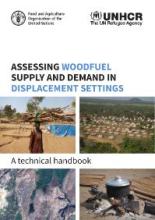/ library resources
Showing items 1 through 9 of 17.The recent increase in urban areas has stimulated landscape urbanization. One of the ways to study this process is an analysis based on the structure of land cover.
This manual presents a methodology for assessing woodfuel supply and demand at the level of the displacement camp through the collection of primary data in the field and remote sensing analysis.
Grassland is a land cover in the area of conflict between agriculture and conservation, where intensification of land use is a major threat to grassland biodiversity.
Three global datasets, the History Database of the Global Environment (HYDE), Kaplan and Krumhardt (KK) and Pongratz of reconstructed anthropogenic land cover change (ALCC) were introduced and compared in this paper.
The Berchtesgaden National Park (Bavaria, Germany), a study site of the UNESCO Man and the Biosphere program in the catchment of Berchtesgadener Ache, is introduced as a platform for interdisciplinary research.
The German Remote Sensing Data Center operates the Biosphere Energy Transfer Hydrology Model, a process model that estimates the net primary productivity of agricultural areas. The model is driven by remote sensing data and meteorological data.
The urban heat island effect poses a challenge in several cities, and may affect human and ecosystem health.
Land use change has a major impact on goods and services that our environment supplies for society.
The paper presents a case study in which land use strategies to mitigate Climate Change effects are developed for a model in Saxony, Germany. In this region, the degree of freedom to respond to Climate Change with land-cover changes is very small.
Pagination
Land Library Search
Through our robust search engine, you can search for any item of the over 73,000 highly curated resources in the Land Library.
If you would like to find an overview of what is possible, feel free to peruse the Search Guide.



